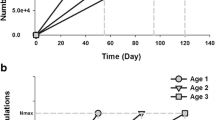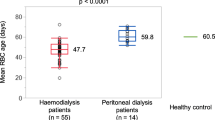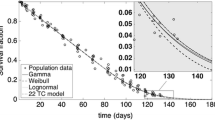Abstract
Shortened red blood cell (RBC) lifespan is one of the major factors contributing to anemia in end-stage renal disease (ESRD) patients and should be taken into account in anemia management protocols. In this study, we aimed to estimate RBC lifespan and the source of between-subject variability in ESRD patients. The resulting individual parameters (empirical Bayes estimates) were used to predict hemoglobin concentrations 2 weeks in advance. The reticulocyte-based estimation of RBC lifespan (REBEL) and the population modeling of RBC count data were used. A total of 120 blood samples collected biweekly over 10 weeks in 24 patients receiving maintenance doses of recombinant human erythropoietin (rHuEPO) subcutaneously were included in this analysis. Typical RBC lifespan was estimated to be 63.3 days. RBC lifespan was found to increase with erythroferrone, a recently identified hormone participating in iron metabolism. Approximately, a 10% increase in plasma erythroferrone was associated with a 5% increase in RBC lifespan. In addition, RBC lifespan was 18.7% shorter in females compared with males. Out of 24 subjects, 16 had hemoglobin concentrations predicted within 95% prediction intervals. The median absolute prediction error was 15.9% (interquartile range, 9.5 to 24.7%). We demonstrated that REBEL coupled with the population modeling technique can be used effectively to estimate RBC lifespan. Then, individual parameters can be used to predict future hemoglobin concentrations in ESRD patients.





Similar content being viewed by others
References
Hsu CY, McCulloch CE, Curhan GC. Epidemiology of anemia associated with chronic renal insufficiency among adults in the United States: results from the Third National Health and Nutrition Examination Survey. J Am Soc Nephrol. 2002;13(2):504–10.
McClellan W, Aronoff SL, Bolton WK, Hood S, Lorber DL, Tang KL, et al. The prevalence of anemia in patients with chronic kidney disease. Curr Med Res Opin. 2004;20(9):1501–10.
Stauffer ME, Fan T. Prevalence of anemia in chronic kidney disease in the United States. PLoS One. 2014;9(1):e84943.
Vos FE, Schollum JB, Coulter CV, Doyle TC, Duffull SB, Walker RJ. Red blood cell survival in long-term dialysis patients. Am J Kidney Dis. 2011;58(4):591–8.
Loge JP, Lange RD, Moore CV. Characterization of the anemia associated with chronic renal insufficiency. Am J Med. 1958;24(1):4–18.
Desforges JF, Dawson JP. The anemia of renal failure. AMA Arch Intern Med. 1958;101(2):326–32.
Alfrey CP, Rice L, Udden MM, Driscoll TB. Neocytolysis: physiological down-regulator of red-cell mass. Lancet. 1997;349(9062):1389–90.
Handelman GJ, Levin NW. Red cell survival: relevance and mechanism involved. J Ren Nutr. 2010;20(5):S84–8.
Sargent JA, Acchiardo SR. Iron requirements in hemodialysis. Blood Purif. 2004;22(1):112–23.
Kalicki RM, Uehlinger DE. Red cell survival in relation to changes in the hematocrit: more important than you think. Blood Purif. 2008;26(4):355–60.
Elliott S, Pham E, Macdougall IC. Erythropoietins: a common mechanism of action. Exp Hematol. 2008;36(12):1573–84.
Krzyzanski W, Brier ME, Creed TM, Gaweda AE. Reticulocyte-based estimation of red blood cell lifespan. Exp Hematol. 2013;41(9):817–22.
Berlin NI, Dudley RA, Garby L, Heimpel H, Lee M, Lewis SM, et al. Recommended method for radioisotope red-cell survival studies. Br J Haematol. 1980;45(4):659–66.
Franco RS. The measurement and importance of red cell survival. Am J Hematol. 2009;84(2):109–14.
Mock DM, Lankford GL, Widness JA, Burmeister LF, Kahn D, Strauss RG. Measurement of red cell survival using biotin-labeled red cells: validation against Cr-51-labeled red cells. Transfusion. 1999;39(2):156–62.
Krishnan SM, Dixit NM. Estimation of red blood cell lifespan from alveolar carbon monoxide measurements. Transl Res. 2009;154(1):15–7.
Kautz L, Jung G, Valore EV, Rivella S, Nemeth E, Ganz T. Identification of erythroferrone as an erythroid regulator of iron metabolism. Nat Genet. 2014;46(7):678–84.
Ganz T, Nemeth E. Iron balance and the role of hepcidin in chronic kidney disease. Semin Nephrol. 2016;36(2):87–93.
Wiczling P, Krzyzanski W. Method of determination of the reticulocyte age distribution from flow cytometry count by a structured-population model. Cytometry A. 2007;71(7):460–7.
Wiczling P, Krzyzanski W. Flow cytometric assessment of homeostatic aging of reticulocytes in rats. Exp Hematol. 2008;36(2):119–27.
Mandema JW, Verotta D, Sheiner LB. Building population pharmacokinetic-pharmacodynamic models .1. Models for covariate effects. J Pharmacokinet Biopharm. 1992;20(5):511–28.
Kruse A, Uehlinger DE, Gotch F, Kotanko P, Levin NW. Red blood cell lifespan, erythropoiesis and hemoglobin control. Contrib Nephrol. 2008;161:247–54.
Mentzer WC, Kan YW. Prospects for research in hematologic disorders: sickle cell disease and thalassemia. JAMA. 2001;285(5):640–2.
Belfield KD, Tichy EM. Review and drug therapy implications of glucose-6-phosphate dehydrogenase deficiency. Am J Health Syst Pharm. 2018;75(3):97–104.
Kwack C, Balakrishnan VS. Managing erythropoietin hyporesponsiveness. Semin Dial. 2006;19(2):146–51.
Korell J, Vos FE, Coulter CV, Schollum JB, Walker RJ, Duffull SB. Modeling red blood cell survival data. J Pharmacokinet Pharmacodyn. 2011;38(6):787–801.
Uehlinger DE, Gotch FA, Sheiner LB. A pharmacodynamic model of erythropoietin therapy for uremic anemia. Clin Pharmacol Ther. 1992;51(1):76–89.
Pasricha SR, McHugh K, Drakesmith H. Regulation of hepcidin by erythropoiesis: the story so far. Annu Rev Nutr. 2016;36:417–34.
Drakesmith H, Nemeth E, Ganz T. Ironing out ferroportin. Cell Metab. 2015;22(5):777–87.
Gaiter-Gvili A, Schechter A, Rozen-Zvi B. Iron deficiency anemia in chronic kidney disease. Acta Haematol. 2019;142(1):44–50.
Kramer HM, Curhan GC, Singh A, Grp HS. Permanent cessation of menses and postmenopausal hormone use in dialysis-dependent women: the HELP study. Am J Kidney Dis. 2003;41(3):643–50.
Lin CT, Liu XN, Xu HL, Sui HY. Menstrual disturbances in premenopausal women with end-stage renal disease: a cross-sectional study. Med Princ Pract. 2016;25(3):260–5.
Cochrane R, Regan L. Undetected gynaecological disorders in women with renal disease. Hum Reprod. 1997;12(4):667–70.
Krzyzanski W, Perez-Ruixo JJ. An assessment of recombinant human erythropoietin effect on reticulocyte production rate and lifespan distribution in healthy subjects. Pharm Res. 2007;24(4):758–72.
Wiczling P, Ait-Oudhia S, Krzyzanski W. Flow cytometric analysis of reticulocyte maturation after erythropoietin administration in rats. Cytometry A. 2009;75(7):584–92.
Funding
This study was financially supported by the Bristol-Myers Squibb fellowship to Ly Minh Nguyen and the New Investigator Award grant from the American Association of Colleges of Pharmacy to Calvin J. Meaney. The study was performed independently of all funders.
Author information
Authors and Affiliations
Corresponding author
Ethics declarations
All procedures performed in this study were approved by the State University of New York at Buffalo Institutional Review Board (STUDY00000261) and in accordance with the 1964 Helsinki declaration and its later amendments or comparable ethical standards. Informed consent was obtained from all individual participants included in the study.
Additional information
Publisher’s Note
Springer Nature remains neutral with regard to jurisdictional claims in published maps and institutional affiliations.
Rights and permissions
About this article
Cite this article
Nguyen, L.M., Meaney, C.J., Rao, G.G. et al. Application of Reticulocyte-Based Estimation of Red Blood Cell Lifespan in Anemia Management of End-Stage Renal Disease Patients. AAPS J 22, 40 (2020). https://doi.org/10.1208/s12248-020-0424-9
Received:
Accepted:
Published:
DOI: https://doi.org/10.1208/s12248-020-0424-9




